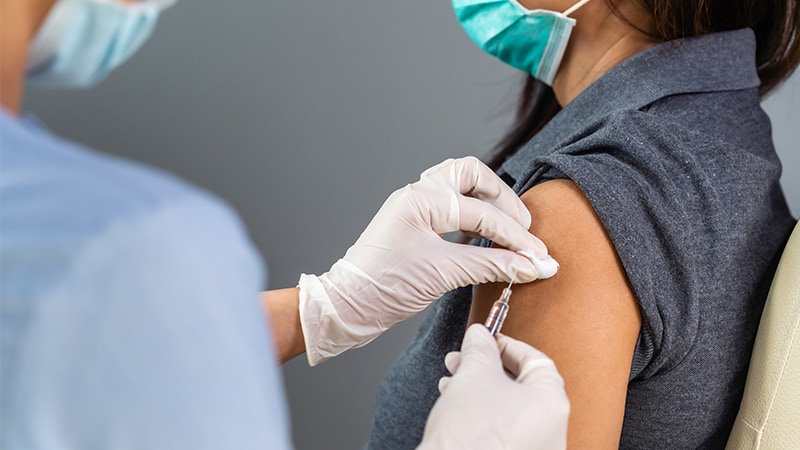Despite Canadian government policies that prioritized indigenous populations for COVID-19 vaccination, vaccine uptake was lower than in the general population for First Nations, Inuit, and Métis living in two urban areas in the province of Ontario.
Rates of vaccination against COVID-19 were 58% among First Nations, Inuit, and Métis living in Toronto, Ontario, but for the general population of Torontonians as a whole, that rate was 80%.
Similarly, in London, Ontario, the vaccination rate among First Nations, Inuit, and Métis was 62%, compared with 82% for the overall London population.
The study was published in the Canadian Medical Association Journal (CMAJ).
“We did the study because there was an absence of any COVID outcome data, basic outcome data, for any First Nations, Inuit, and Métis Peoples populations in Canada that were living in urban centers,” lead author Janet Smylie, MD, MPH, from Well Living House, St. Michael’s Hospital, and the Dalla Lana School of Public Health, University of Toronto, Toronto, Ontario, Canada, told Medscape Medical News.
First Nations, Inuit, and Métis are at higher risk of SARS-CoV-2 infection and COVID-19 because they often have other chronic diseases, and other risk factors, such as inadequate housing and poor access to healthcare services.

Dr Janet Smylie
More than half of indigenous peoples in Canada live in urban areas, Smylie said.
“The majority of indigenous people, including the majority of First Nations, Inuit, and Métis Peoples in Canada live in urban centers, but they are often excluded from health information systems, because they are not on reserves,” she said.
“Getting good data to address this gap in SARS-CoV-2 information among this group is key to providing quality care. In this case, we are looking at a population of almost 120,000 First Nations, Inuit, and Métis Peoples living in the large urban centers of Toronto and London, but if we continue to ignore getting good quality health information for these populations in cities, we’re going to mask inequities, and we will have ongoing inequitable health outcomes, including in groups that lag behind in their vaccinations,” Smylie said.
She and her team partnered with indigenous agencies that were specifically formed to address gaps in health and social information for First Nations, Inuit, and Métis living in urban areas and analyzed two cohorts: Our Health Counts Toronto (n = 723 individuals) and Our Health Counts London (n = 364 individuals).
They prospectively monitored rates of SARS-CoV-2 incidence, vaccine uptake, and testing for SARS-CoV-2 in First Nations, Inuit, and Métis living in those two cities and compared them with those of the general population.
The analysis showed an observed incidence rate of SARS-CoV-2 infection more than twice that of the local population amongst First Nations, Inuit, and Métis living in London. However, the researchers concluded, upon further analysis, that the cumulative rates for First Nations, Inuit, and Métis in both London and Toronto were not significantly different from those of the general population.
There were striking and consistent disparities in vaccine uptake among First Nations, Inuit, and Métis living in Toronto and London compared with overall city and provincial populations.
As of Dec. 6, 2021, the rate of complete vaccination in Toronto among First Nations, Inuit, and Métis was 58.2% (95% CI, 51.4%-64.9%), compared with 79.4% for the overall population of Toronto.
In London the rate of two-dose vaccination for First Nations, Inuit, and Métis was 61.5% (95% CI, 52.9%-70.0%), compared with 82.1% for the overall London population. Adjusting for age had little impact on these results.
SARS-CoV-2 testing rates were modestly higher (10%) among First Nations, Inuit, and Métis living in Toronto compared with testing rates among both First Nations, Inuit, and Métis living in London, as well as the general population of both cities.
“We’d like to think that’s in response to the many efforts that occurred locally to create indigenous-specific testing sites,” Smylie noted.
The study’s secondary analyses found crude rates of hospital admission for COVID-19 among First Nations, Inuit, and Métis in Toronto that were 3.5 times higher than those of the general population of Toronto.
“Our preliminary findings of higher rates of hospital admission among First Nations, Inuit, and Métis with COVID-19 in Toronto compared with the general population could be attributed to a high burden of comorbid chronic disease among these populations in Toronto, which could result in more COVID-19,” Smylie suggested.
A major barrier to care and seeking vaccines among First Nations, Inuit, and Métis is lack of trust in the healthcare system, and the rude and insensitive way indigenous peoples are generally treated not only in Toronto, but all over the world, she said.
Many Métis, for example, will not admit to being Métis.
“People often assumed my mother was Greek,” Smylie, who is Métis, recounted. “Oftentimes, because I am Métis, I won’t correct that, and many of us won’t because we’re worried that it might result in different treatment. Even in the hospitals in Toronto. But it’s not just Toronto, it’s everywhere. As an indigenous physician, and I have been in practice for 29 years, I’ve heard it from hospitals across Canada and the US and I have witnessed acts of racism happening across not only urban but rural healthcare settings.”
Often, medical staff mistakenly diagnose a person who is suffering a stroke or diabetes-related issue, or other serious medical issue as being intoxicated and fail to do a proper workup.
“It’s happened in my own family,” Smylie said. “It’s happened to my partner recently. It’s just substandard care but unfortunately is much more common than we would hope for.”
Obtaining Good Data Is Essential
“Population-based data doesn’t exist for indigenous people,” co-author Cheryllee Bourgeois, BHSc, Seventh Generation Midwives Toronto and Call Auntie Clinic, Toronto, told Medscape Medical News.

Cheryllee Bourgeois
“As this study shows, when the community has access to good data, we can see where we need to improve, or where we are doing okay, or where we are doing great. The data are very effective when the indigenous community can actually use it and make ongoing, real-time decisions regarding their care,” Bourgeois, who is Métis, said.
“We are lucky in Toronto to have these kinds of data, but it is unusual to have it,” she added.
“By harnessing and analyzing the data as Michael [Rotondi, PhD, the statistician in the study], has done, we see very clearly that we are only at 50% vaccination rate, and our testing rate hovers near that, when the rest of the city is reporting an 80%-90% vaccination or testing rate. So, there is a gap,” Bourgeois said. “Now we know, and we can try to fix it.”
A Meaningful Partnership
“This study is very interesting, and it speaks to the importance of meaningful partnerships between academic researchers and indigenous communities,” Russell de Souza, associate professor in the Department of Health Research Methods, Evidence, and Impact at McMaster University, Hamilton, Ontario, Canada, commented to Medscape Medical News.
“Fostering trust between public health researchers and members of indigenous communities is necessary. Providing vaccines is important, but a culturally safe approach, which acknowledges and addresses the impact of colonialism and the historical mistrust of vaccination programs, is imperative for success,” de Souza, who was not part of the study, said.

Russell de Souza
Involving community members and indigenous healthcare providers in the development of vaccination strategies will help manage future pandemics and improve equitable access to care, said de Souza.
“Although many First Nations, Inuit, and Métis communities reacted quickly to the pandemic, this study helps us understand structural factors that delayed access to and uptake of vaccines in cities. The results of studies like this will help communities prepare for future pandemics and improve equitable access to care — for example, increase the availability of culturally sensitive information and sites to receive vaccines. It is important that pandemic response strategies acknowledge historical mistrust of vaccination programs, and are developed in partnership with indigenous communities, with an understanding of the colonial history and oppression they suffered.”
Smylie reports grants from the Canadian Institutes of Health Research and Indigenous Services Canada, and that she is supported by a Tier 1 Canada Research Chair in Advancing Generative Health Services for Indigenous Populations in Canada. Bourgeois and de Souza report no relevant financial relationships. The study was supported by ICES through the Applied Health Research Question program, which is funded by the Ontario Ministry of Health and Long-Term Care. This study was also supported by the Canadian Institutes of Health Research COVID-19 Rapid Research Operating grant.
CMAJ. Published Aug. 2, 2022. Full text.
For more news, follow Medscape on Facebook, Twitter, Instagram, and YouTube.
Source: Read Full Article



